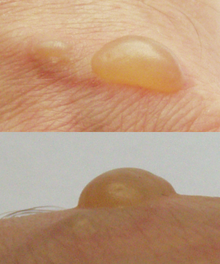Burn blister
| Classification according to ICD-10 | |
|---|---|
| T20.2 to T25.2 | 2nd degree burns denotes localization |
| T29.2 | Burns in several parts of the body, at most 2nd degree burns |
| T30.2 | 2nd degree burn, body region unspecified |
| ICD-10 online (WHO version 2019) | |
A burn blister is a blistering of the skin between the upper skin (epidermis) and dermis (corium) caused by the action of heat . It is filled with "tissue water" ( serous transudate ) . Since the papillary layer ( stratum papillare ) is preserved, healing takes place without scarring. Blisters are among the burns 2nd degree.
The resulting bubble ensures that the actual injury is hermetically sealed from the environment. The wound thus remains sterile and can be ideally supplied with oxygen and other nutrients from the capillaries contained in the papillary layer , which has a positive effect on healing. Blisters can be painful, but usually heal without consequences after a few days. The bladder is painful for the first few hours until it is filled with wound fluid. Immersion in cold water has a pain reliever effect. After approx. 1 week, the blisters will break down on their own. The wound water recedes and the blisters collapse with wrinkled skin. After 1 to 2 days, the epidermis sticks to the dermis and hardens.
Injury to the bladder, for example by puncturing, can allow germs access to the wound and worsen the healing process or lead to scarring. In the event of inflammation, this should be treated by a doctor.


